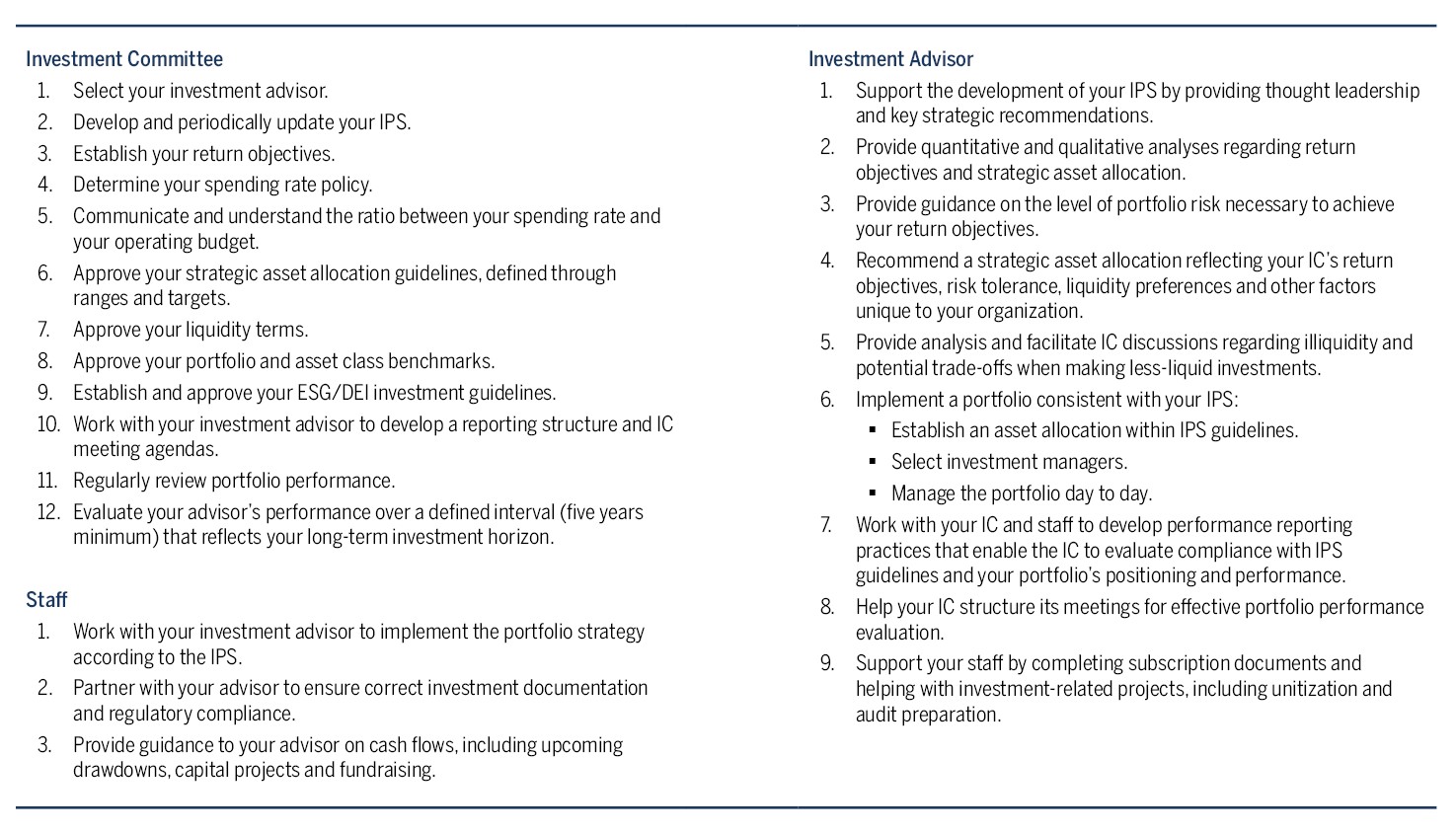Leaders of mission-driven nonprofit organizations understand that their board’s investment committee (IC) typically shoulders the greatest share of responsibility in developing and fostering the organization’s relationship with an investment advisor.
For many endowments and foundations (E&Fs), working with a new advisor can offer a great opportunity to consider aspects of board governance that should ensure a smooth transition and a successful, long-term, collaborative partnership. At Brown Advisory, over decades of work investing on behalf of E&Fs, we have learned from our clients the key questions to ask and critical choices to make that can enable the IC and investment advisor to optimally fulfill their mutual responsibilities.
The right governance structure, including a clear allocation of roles and responsibilities among the advisor, IC and staff, seeks to lay the foundation for efficient and effective strategic investment decision-making that nimbly adapts to evolving market conditions while supporting an organization’s long-term mission and evolving programs.
STRUCTURE YOUR IC TO SUPPORT YOUR LONG-TERM INVESTMENT GOALS
In our experience, the most consistently effective and high-functioning ICs share certain common structural features:
- They plan and manage IC membership and leadership. The most efficient ICs typically have five to 12 seats. An IC with four members or fewer runs the risk of an insufficient diversity of views, while one with more than 12 members may prove unwieldy and have difficulty reaching consensus. Similarly, establishing a timeline and process for the IC chair’s term and rotation is essential to maximizing smooth continuity in governance.
- The IC’s tenure system reflects the portfolio’s long-term investment horizon. Term limits of three to seven years and a system of staggered turnover help ensure a measured and consistent transition in IC membership. The goal is to balance continuity of institutional knowledge and consistency in governance with a regular infusion of fresh perspectives.
- The IC makes a limited number of key decisions annually. Even the most effective committees can only make a handful of well-reasoned and impactful decisions each year. ICs, which generally meet infrequently and often for only an hour, are no exception and should purposely work with their investment advisor to focus on the right questions at meetings.
Of course, these are broad guidelines, and organizations may make somewhat different choices, conscious of the trade-offs involved. As a good partner, the investment advisor’s role is to support an organization’s governance structure and make recommendations for improvement based on years of experience working with similar institutions. Open communication and patience are critical, as the collaborative relationship between an IC and a new investment advisor can take as long as a decade to reach its full potential.
LAY THE FOUNDATION FOR COLLABORATIVE SUCCESS IN YOUR INVESTMENT POLICY STATEMENT
We believe that embarking on a partnership with a new investment advisor offers your IC the ideal opportunity to revisit your organization’s investment policy statement (IPS). From the outset, the IC should consciously own and always maintain ownership of the IPS on the organization’s behalf. A good investment advisor can support the revision process by asking probing questions, recommending modifications, candidly assessing trade-offs of potential options and helping synthesize IC members’ ideas. Important considerations that should be defined in the IPS include the organization’s return objectives, risk tolerance, liquidity preferences, and approach to environmental, social, and governance (ESG) and diversity, equity, and inclusion (DEI) criteria.
The advisor may be of particular help when an IC is transitioning to a new model of investment management. At one end of the spectrum, an IC may have worked with an investment consultant, who is typically restricted to researching and making recommendations on investments whereby the IC makes all decisions and implements the portfolio. At the other end, an IC may have previously delegated total discretion to an outsourced investment provider running a single commingled fund, which, in effect, forfeits the IC’s ownership of the IPS.
In our view, these extremes present flawed models—we believe that effective accountability lies between them. The optimal approach is for the investment advisor to implement the portfolio after collaborating with the IC to define the portfolio guidelines and expectations documented in the IPS. The advisor takes responsibility for day-to-day portfolio management consistent with the guidelines detailed in the IPS—which means, ultimately, being consistent with your organizational mission.
TAKE ADVANTAGE OF YOUR IPS TO CODIFY ROLES AND RESPONSIBILITIES
One of the primary purposes of the IPS is to clearly delineate the interlocking responsibilities of the IC, investment advisor and staff. The IPS can define who is accountable for what and why, and identifies the tools to evaluate progress in realizing your investment goals. We believe that three considerations underlie the rationale for this allocation of roles:
- Your IC is best positioned to address high-level portfolio considerations reflecting your institutional mission. Your board members typically have more intimate and comprehensive knowledge of your organization than your investment advisor, including personal connections, affinity and long-term institutional knowledge. IC members also typically participate on other board committees or subcommittees, such as oversight, finance and audit—knowledge from that service can inform their participation on the IC and impact portfolio considerations.
- Your investment advisor is well-positioned to provide recommendations and guidance on big-picture issues. Drawing upon experience working with peer organizations, your advisor understands the challenges facing endowments and foundations. They can help the IC work through complicated policy considerations, like striking the right balance between illiquidity and return expectations. In our experience, many ICs demand more liquidity than they actually need, and doing so can reduce return potential. By presenting analysis and sharing insight into the approach of peer organizations, the advisor can help the IC determine the best approach for their organization.
- Your investment advisor is better positioned than your IC to manage your portfolio day to day. Your advisor maintains a full-time, up-close focus on investment markets and regularly meets with the fund managers they select for your portfolio. In contrast, most ICs meet at infrequent intervals, typically four to six times per year, and IC members usually have other responsibilities limiting their ability to think about the portfolio on a daily basis. Your advisor should be able to make critical, tactical decisions outside of the IC’s regular meeting schedule in a timely way to take advantage of market changes.
ALLOCATING RESPONSIBILITIES FOR INVESTMENT GOVERNANCE
In our experience, the optimal division of responsibilities among the IC, the investment advisor and staff might look like the following:

BROWN ADVISORY CAN HELP
In identifying the right investment advisor for your organization, you will want a partner with a meaningful history of successful collaboration. At Brown Advisory, we have decades of experience serving many different types of nonprofits, including educational endowments, private foundations, hospital systems and cultural organizations. We work with mission-driven nonprofits ranging from local organizations with portfolios valued at $5 million to national organizations with more than $2 billion in investments.
At Brown Advisory, we foster a culture of low team turnover that seeks to serve every aspect of your long-term strategy. We focus on customizing our services to each client, providing a “bespoke” experience tailored to your evolving needs. We strive to learn from every client as we help them to educate themselves about the evolving investment landscape. And when an organization experiences turnover in board membership, especially in its IC or among key staff members, we are there to serve as your vault of institutional knowledge. 
The views expressed are those of Brown Advisory as of the date referenced and are subject to change at any time based on market or other conditions. These views are not intended to be and should not be relied upon as investment advice and are not intended to be a forecast of future events or a guarantee of future results. Past performance is not a guarantee of future performance and you may not get back the amount invested.
ESG considerations that are material will vary by investment style, sector/industry, market trends and client objectives. Ours strategies seek to identify companies that we believe may have desirable ESG outcomes, but investors may differ in their views of what constitutes positive or negative ESG outcomes. As a result, our strategies may invest in companies that do not reflect the beliefs and values of any particular investor. Our strategies may also invest in companies that would otherwise be screened out of other ESG oriented portfolios. Security selection will be impacted by the combined focus on ESG assessments and forecasts of return and risk. Our strategies intend to invest in companies with measurable ESG outcomes, as determined by Brown Advisory, and seek to screen out particular companies and industries. Brown Advisory relies on third parties to provide data and screening tools. There is no assurance that this information will be accurate or complete or that it will properly exclude all applicable securities. Investments selected using these tools may perform differently than as forecasted due to the factors incorporated into the screening process, changes from historical trends, and issues in the construction and implementation of the screens (including, but not limited to, software issues and other technological issues). There is no guarantee that Brown Advisory’s use of these tools will result in effective investment decisions.
The information provided in this material is not intended to be and should not be considered to be a recommendation or suggestion to engage in or refrain from a particular course of action or to make or hold a particular investment or pursue a particular investment strategy, including whether or not to buy, sell, or hold any of the securities mentioned. It should not be assumed that investments in such securities have been or will be profitable. To the extent specific securities are mentioned, they have been selected by the author on an objective basis to illustrate views expressed in the commentary and do not represent all of the securities purchased, sold or recommended for advisory clients. The information contained herein has been prepared from sources believed reliable but is not guaranteed by us as to its timeliness or accuracy, and is not a complete summary or statement of all available data. This piece is intended solely for our clients and prospective clients, is for informational purposes only, and is not individually tailored for or directed to any particular client or prospective client.

